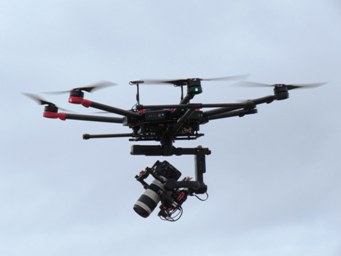Australia So Much to See
Incidents like these may eventually result in stricter regulations; see Midair tragedy waiting to happen and Drones shut down Dubai airport.
Recently there have been reports of drones being used to observe bushfires. This practice puts emergency services in jeopardy. Firefighting planes will have to stop working. Similarly this also applies in other emergencies such as accidents and floods. If you fly, they can't. One incidence of this occurred in Tasmania at Bruny Island.
The reports keep on coming with reports of drones in the air endangering fire fighting aircraft at Esperance during a bushfire emergency in April 2017, and on the same day new reports about recent incidents of drones flying close to aircraft in Aviation authorities are investigating claims a drone came dangerously close to a Singapore Airlines plane as it flew above the Swan River. Drone operators who are caught breaching the law can face fines of up to $9000.

New regulations mooted as Australia’s Civil Aviation Safety Authority (CASA) is preparing to relax restrictions on the use of small drones by commercial operators. During April and May 2016 a few changes to the regulations coming into force in September 2016 have been revealed. The new laws only apply to drones weighing less than two kilogrammes. They do not apply to private or hobby drones that are unregulated part from having to abide by the regulations where they can and can't be flown.
Commercial operators of these small drones will no longer need to hold an operator’s certificate and remote pilot licence. Drone pilots will need to register with CASA and describe the areas in which they plan to fly drones before being legally allowed to fly drones commercially.
They will also be required to apply for CASA approval for each time they use the drone, which will be done on line when the website is created. They will also need to abide by the regulations of where drones can and can't be flown.
Farmers will be able to use a small drone if under two kilogrammes over their own land without obtaining a commercial licence, so long as it is for their own use and not for profit.
Will the new regulations assist the industry? It will mean less costs of registration for operators of these very small drones. It will mean a little more work in logging in flight plans. It may mean those with larger drones which will still have the same licensing requirements they have now will feel disadvantaged.
Will these changes lead to more incidents and accidents? CASA does not have to staff to ensure that drones are only flown in permitted areas and in line with their logged flight plans. With increasing numbers of drones used, there will continue to be incidents such as outlined on the previous page. It will still be up to the operators.
A flying object even as light as two kilogrammes still present much the same threat to flying aircraft and the person on the ground. The article can only be viewed if you are a subscriber of The Australian news website.
Post September 2016, the regulations now in force can be seen in full on CASA Flying Drones or Model Aircraft
A variety of occurrences are considered in this article
12 ways your drone can land you in trouble, including interaction with eagles, accidents when people have been trying to
recover their drone, minimum distances for flying near whales, dolphins and other marine animals, transporting lithium batteries
if travelling by air, and using drones when overseas.
With marine animals, a maximum fine of $110,000 for breaching
these approach distances can apply.
Updated April 2017
What will happen next?
While there are no further rules in the making, as more and more drones are used, private owners registering is not out of the question in the future. Stricter air rules will eventually be needed to ensure drones to not collide, with potential damaging consequences depending on where they crash land.

CASA is proposing an accreditation and licensing system for drones over 250 grams. You will have to do an online education course – basically, watch a video and answer a quiz on the drone rules that apply to you.
We recently published a series of amendments and exemptions to some drone rules. If you're flying for business or as part of your job, these changes may affect you.
* operators flying a drone that weighs 250 g or less in commercial operations can apply for approval to operate closer than 30 m of other people, including those who are not directly assisting with the operation of the drone - see CASA 22/21.
* operators can apply to operate more than one drone at a time. For example, swarm operations or similar - see CASA 22/21.
* education providers are exempt from getting a licence or certification when operating a drone up to 7kg for education, research or training purposes - see CASA EX37/21.
* licensed operators can fly a different category of small or medium drone (standard operating conditions only) to get experience for their flight tests - see CASA EX38/21.
* some commercial operators can apply to operate their drone beyond visual line of sight, without having passed an examination. However, certain conditions still apply. For example, supervision and direction of another remote pilot who has passed the examination may be required - see CASA EX46/21.